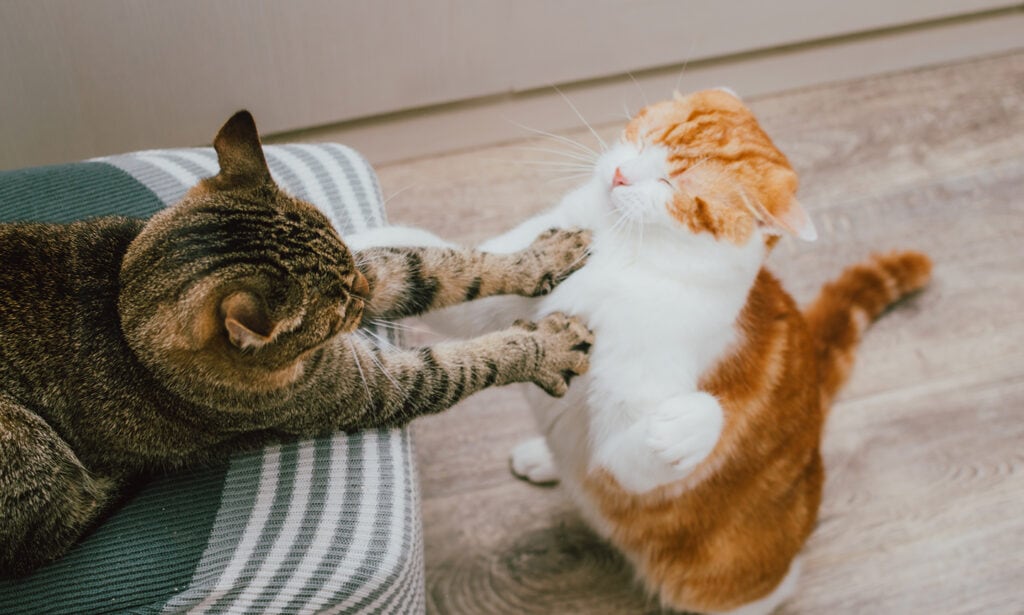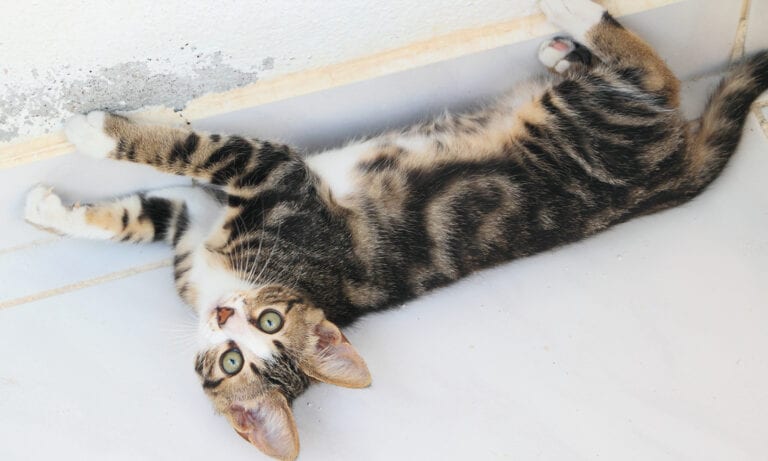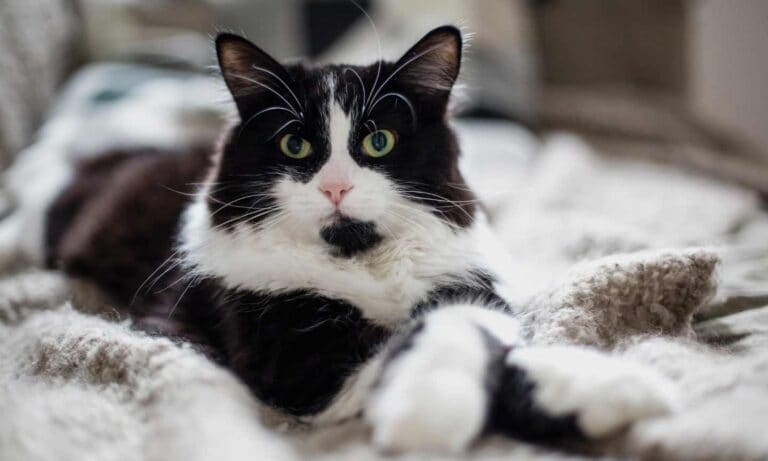Cats play fighting is healthy, normal behavior. It’s centered around cats’ predatory behavior, which is why you’ll see lots of pouncing, stalking, chasing, grabbing, wrestling and bunny kicking with the back legs. But sometimes it can be a struggle to tell the difference between cats playing rough and actually fighting because both look similar. And if one of the cats takes things too far, what starts as a friendly wrestling match can escalate into a true knock-down, drag-out fight.
How to Tell If Cats Are Playing or Fighting?
To determine if your cats are playing or fighting, observe their body language as well as the nature of the “fight.” Dr. Ernie Ward, DVM, author and Chief Veterinary Officer at VerticalVet, says to watch for the following signs.
Signs Your Cats Are Playing
- Both cats are calm and happy during the rough play session.
- Play is balanced, with both cats engaging in roughhousing, taking turns being on top, rolling onto their sides and backs or chasing each other.
- Body stance is forward and facing each other.
- Ears are in their normal, forward position.
- Hair is flat (no puffed-up tails).
- Biting is minimal and can be considered play biting or nipping.
- Friendly play does not include clawing, swatting, hissing or growling.
Signs Your Cats Are Fighting
- Eyes are wide open with dilated pupils.
- Ears are flattened against the cats’ heads.
- Whiskers point forward.
- Mouths are open, often with teeth bared.
- The cats vocalize through hissing or growling.
- The hair on the tail and body is puffed up (called piloerection).
- Body posture is tense and sideways, rather than facing each other.
- Claws are out and used for swatting or hitting.
- Tails raised or lashing back and forth or twitching.
Cat Fight Noises
While vocalization can be a normal part of roughhousing or playing, those sounds are more measured and subdued, like the occasional squeal, Dr. Ward says. Fighting is a different story, however, and there is no mistaking the sound of a cat fight:
- Guttural meowing
- Hissing
- Growling
- Yowling
These sounds can be frightening to someone who’s never heard it before. If you’re lucky enough to have never heard a cat fight, here’s an example:
Why Do Cats Play Fight?
Cats obviously can’t sit down to a fun board game (although that would be amazing), but they find other ways to play. We’ve all seen cats batting at toys or chasing them through the house, or wrestling with a kicker toy, but when they play with each other, it’s usually in the form of play fighting or play hunting.
“Feline play hunting is a deeply ingrained behavior,” says Dr. Ward. “While we can’t be certain what cats think when engaged in play hunting, we can surmise they’re role-playing based on their actions. Cats stalk and pounce to keep their survival skills sharp. It doesn’t matter if the game is real or not as long as the cats are able to occupy their thoughts and motions in play.”
Why Do Cats Fight?
We want our cats to get along, but real fighting can and does happen. Every cat and situation is different, but six common reasons for fighting include:
1. Territorial Issues
As territorial creatures, cats will often fight to protect what they believe is theirs—whether it’s attention from their favorite human, a preferred spot on the couch or the entire living room.
2. Competition for Resources
Cats also like to claim items (such as toys, food bowls and litter boxes) as their own. If another cat dares to swipe a favorite toy or eat from an “off-limits” food bowl, a fight can easily break out.
3. New Cat in the Home
“Unfortunately, many new kittens or cats will often receive a hostile reception from the other household cats,” Dr. Ward says. “The other cat usually sees no need for a kitten in the household, and these feelings are reinforced if they perceive that favoritism is being shown to the kitten.”
4. Redirected Aggression
When a cat gets excited or upset by a stimulus (like a bird outside the window) but can’t get to it, they might redirect that aggression toward something or someone else—often the unwitting cat who just happens to be nearby.
5. The Cats Just Don’t Like Each Other
Some cats simply can’t get along. Reasons may include the following, according to Dr. Ward:
- Personality clash
- Competition for resources or attention
- Too great of an age or ability gap
“Many multi-cat households will observe periods of intimacy between two or more cats, followed by times of disaffection and little interaction, then a renewal of interest and interaction," he says. "This appears to be a relatively common and normal behavioral cycle.”
6. Illness
If one cat suddenly shows aggressive behavior, they might be suffering from some type of pain or underlying health issue, so a trip to the vet is in order.
How to Stop Cats Fighting
Break up a cat fight so it doesn’t escalate, but never use your hands, feet or legs to stop the fighting. The cats can easily turn on you instead, and you’re almost guaranteed for the cats to bite or scratch you, both of which can cause injury or infection. Instead, distract them.
To stop cats fighting, Dr. Ward recommends the following distractions:
- If the fighting is mild:
- Redirect their attention with a toy or treat
- Clap your hands loudly
- Give a quick shout to get their attention
- Rattle a can of coins
- If the fighting is severe, throw a towel on them.
- In extreme cases, spray a small amount of water on them, but never use this method as punishment.
Don’t yell at or punish them, Dr. Ward says. “You want the cats to view the interruption as a novel stimulus, not an angry owner.”
Once the fight is over, put them in separate rooms and check for potential bite wounds or other injuries. Keep them separated for a while until everyone calms down.
How to Keep Cats from Fighting
If you have a multi-cat household, you know that the occasional fight can break out. If your cats just won’t give peace a chance, the following can help:
- Get your cat spayed or neutered. This generally reduces aggression and unwanted behaviors.
- Provide plenty of enrichment. Try cat trees, beds and toys, as well as basic resources like litter boxes and food bowls. Dr. Ward also suggests hunting cat feeders to engage their inner predator.
- Use calming pheromones. These mimic a natural cat odor and are thought to be effective in decreasing aggression. These come in sprays and plug-in diffusers, like Feliway's Optimum diffuser, which emits a patented pheromone formula for 30 days.
How to Get Cats to Get Along
Cats need to feel safe in their environment, knowing they’re not in danger and that the resources they need to survive are available. Here are some ways to help your cats get along:
- Ensure proper introductions are made. If you’re bringing a new cat into your home, introduce the cats slowly and do it at the cats’ pace. Read our comprehensive guide on introducing cats.
- Give your cats reasons to like each other. Provide something they both enjoy when they’re together, such as treats, grooming sessions and playtime.
- Spread the love. Give your cats equal attention so they don’t get jealous or feel left out.
- Be aware of any changes in the cats’ environment. Simple things like rearranging furniture or loud noises outside can cause anxiety and make one or more of the cats act out or become aggressive.
Learn more about cat behavior:
Share:













